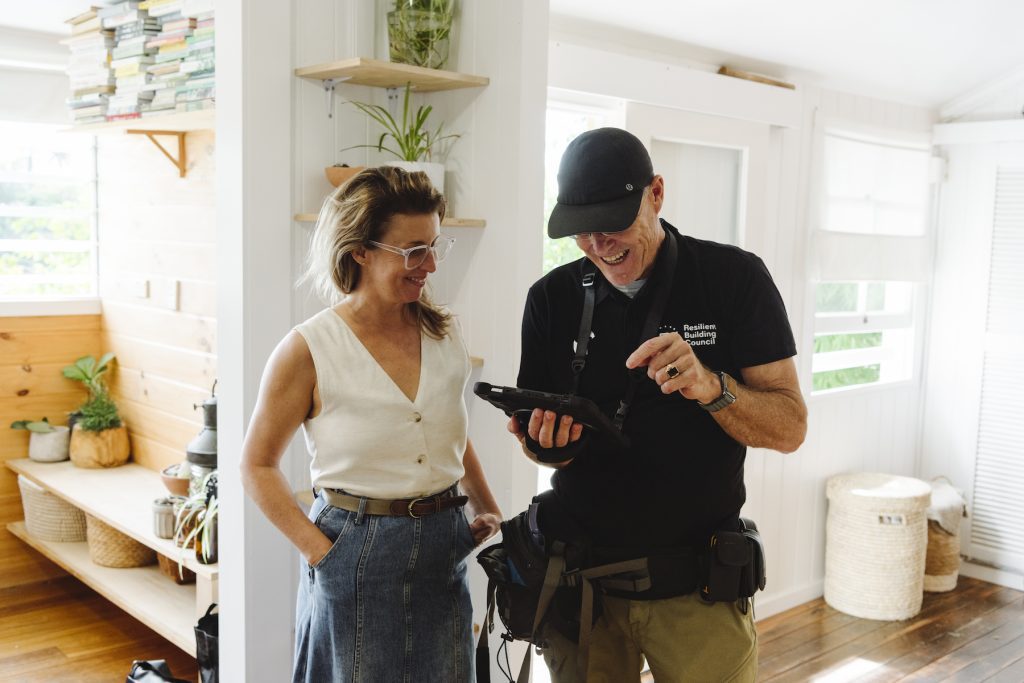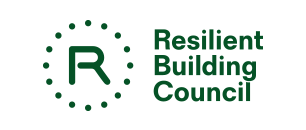The Gold Coast is leading the way on home resilience.
The Gold Coast Household Resilience Ratings Program empowers residents to strengthen their homes against natural hazards such as floods, bushfires, severe storms and tropical cyclones. Through free home assessments, homeowners receive personalised, practical guidance to reduce disaster risk, and unlock insurance and finance benefits.
Developed by Australia’s top experts and led by the independent Resilient Building Council, the Ratings system turns science into simple, practical guidance tailored to your home’s unique features and local hazards.
As part of this free community program, Gold Coast residents with freestanding, detached homes can apply to participate in:

Stage 1 – Free on-site expert assessments for 40 homes.
Expressions of interest closed on Monday 18 August. Homes must meet specific criteria to be selected for participation. Successful applicants will be contacted in September 2025. On-site assessments will be conducted during October and November 2025 by expert assessors.
Stage 2 – Free self-assessments for 1,000 homes.
Expressions of interest will be open from March 2026. Homes must meet specific criteria to be selected for participation.
Selected participants in both stages will receive a Multi-Hazard Resilience Ratings home assessment and customised report – helping you make informed decisions to strengthen your home and support the development of insurance and finance incentives.
This project is supported by the City of Gold Coast and delivered by the Resilient Building Council in partnership with James Cook University Cyclone Testing Station.
Register your interest in Gold Coast project updates
City of Gold Coast Resilience Ratings Project
Frequently Asked Questions (FAQ)
What is the Gold Coast Household Resilience Ratings Program?
The Gold Coast Household Resilience Ratings Program empowers residents to strengthen their homes against natural hazards such as floods, bushfires, severe storms and cyclones. Through free assessments, homeowners receive personalised, practical guidance to reduce disaster risk and better prepare for extreme weather.
This a City of Gold Coast initiative, delivered in partnership with the Resilient Building Council.
What does the program offer?
Participants can access:
- Free on-site expert assessments for 40 homes
- Free supported self-assessments for 1,000 homes using the new Multi-Hazard Resilience Ratings App prototype
- Tailored Resilience Ratings reports showing how homes perform against multiple hazards, and what upgrades will make the biggest impact
- Workshops and resources for homeowners, renters, landlords, trades and community groups
Why does this matter?
The Gold Coast is no stranger to extreme weather, from the 2023-24 Christmas Severe Weather Events to Tropical Cyclone Alfred in 2025. As natural hazard risks increase, so does the need for proactive action.
This program empowers residents and helps provide:
- A clear picture of their home’s vulnerability
- Expert guidance on how to improve it
- Confidence to act before disaster strikes
- More resilient homes mean reduced damage, faster recovery, and safer communities.
How can I participate?
Stage 1 – Free on-site expert assessments for 40 homes.
Expressions of interest closed on Monday 18 August. Homes must meet specific criteria to be selected for participation. Successful applicants will be contacted in September 2025. On-site assessments will be conducted during October and November 2025 by expert assessors.
Stage 2 – Free supported self-assessments for 1,000 homes.
Expressions of interest for Stage 2 will open from March 2026. Homes must meet specific criteria to be selected for participation.
Selected households will receive clear guidance and support to complete their own home assessment using the Multi-Hazard Resilience Ratings App prototype. Support will include online resources, help materials, and one-on-one assistance where needed — helping households confidently generate a customised Resilience Rating Report.
What do I get if I take part?
You’ll receive a customised report tailored to your home and local hazards, expert guidance on what to improve, and support to act on your results, including invitations to resilience workshops. Participants also help shape future insurance, finance and grant solutions.
How do the Resilience Ratings home assessments work?
The Resilience Ratings assessment looks at how well your home can handle natural hazards like floods, bushfires, severe storms and cyclones.
It checks key parts of the home – such as the roof, walls, windows, doors, floors, and essential services – as well as things around the property like sheds, fences and trees. The goal is to identify areas that are vulnerable and recommend practical, often low-cost actions that will make the biggest difference to your safety and resilience.
Assessments can be done by an expert (Stage 1) or supported through a guided self-assessment using the app (Stage 2).
Who developed the Resilience Ratings?
The Resilience Ratings were developed by the independent, not-for-profit Resilient Building Council (RBC) in partnership with leading Australian researchers, builders, engineers and disaster experts.
They are backed by decades of science, field testing, and real-world experience — and designed to provide practical, trusted guidance to help households reduce risk from floods, bushfires, severe storms and cyclones.
The Resilience Ratings Scheme is funded by the National Emergency Management Agency (NEMA), New South Wales Government and Queensland Government, industry sponsors and is delivered with partners including Insurance Council of Australia, James Cook University Cyclone Testing Station and University of Wollongong.
Can this help reduce my insurance?
Yes. Some insurers already recognise certified Bushfire Resilience Ratings with premium discounts. This project expands that work to include other hazards, providing verified data to support fairer pricing.
What types of upgrades might be recommended?
Every home is different. Recommendations will depend on your home’s location, construction, and condition — and may range from small changes to more significant retrofits.
Common higher-impact upgrades may include:
- Strengthening the roof structure and connections
- Upgrading garage doors to cyclone-rated models
- Elevating switchboards, hot water systems or key appliances
- Replacing flammable or water-sensitive external materials
- Improving underfloor airflow or flood resistance
- Installing bushfire shutters or impact-rated glazing
- Some of these actions can be planned over time or included during future renovations.
Can resilience upgrades be low-cost?
Yes. Many effective resilience actions are low-cost and practical, especially when done as part of regular maintenance or during routine upgrades and renovations.
Examples from Resilience Ratings Reports include:
Bushfire:
- Seal gaps around doors, windows and eaves
- Install metal mesh on vents and weepholes
- Remove flammable items from decks and within 10m of the home
- Maintain a non-combustible pathway around the home
Flood:
- Seal cracks in walls and floors
- Elevate services during minor renovations or appliance replacement
- Use water-resistant materials when replacing cabinetry or flooring
- Direct stormwater or runoff away from the house
Storm & Cyclone:
- Install window locks or storm bolts
- Reinforce or brace garage doors
- Replace rusted roof fixings
- Prune trees to reduce the risk of flying debris
- These low-cost actions are a great starting point and can make a meaningful difference to your home’s safety and resilience.
What are the benefits?
By participating, you can:
- Better understand your home’s risk
- Receive clear, trusted advice
- Take meaningful, cost-effective action
- Improve peace of mind and safety
- Contribute to national solutions for resilience and insurance
- Strengthen your community’s ability to prepare and recover
How does my participation make a difference?
You’re not just protecting your home — you’re contributing to national data that helps develop better insurance, mortgage and retrofit programs for all Australians.
How can this help banks and insurers?
Resilience Ratings provide reliable, home-specific data that can help banks and insurers offer:
- Risk-reflective pricing
- Resilience-linked loans
- Targeted grant and support programs
Is it really free?
Yes. The program is fully funded for up to 1,040 homes – including both expert assessments and supported self-assessments.
Who is behind the Gold Coast Household Resilience Ratings Program?
This a City of Gold Coast initiative, delivered in partnership with the Resilient Building Council.
Is my information safe?
Yes. Participation is voluntary and secure. RBC does not share your personal information unless you give permission. Any case study data is de-identified and securely handled.
Read our Privacy Policy: https://rbcouncil.org/privacy-policy
Can renters participate?
Yes. Renters can complete a self-assessment, attend workshops, and share findings with landlords to encourage upgrades.
If I upgrade my home, can I stay during a disaster?
No. Always follow emergency service advice and evacuate early. A stronger home improves survivability but does not replace your evacuation plan.
How do I sign up?
Visit https://rbcouncil.org/gold-coast to express your interest.
Need more information?
Email: info@rbcouncil.org
Or speak with us at a local event.


